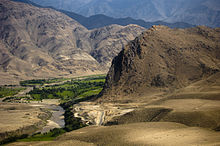Second Battle of Laghman
 From Wikipedia the free encyclopedia
From Wikipedia the free encyclopedia
| Second Battle of Laghman | |||||||||
|---|---|---|---|---|---|---|---|---|---|
| Part of Ghaznavid campaigns in India | |||||||||
 Present day Laghman | |||||||||
| |||||||||
| Belligerents | |||||||||
| | |||||||||
| Commanders and leaders | |||||||||
| | Jayapala | ||||||||
| Strength | |||||||||
| Unknown | 100,000 cavalry+ | ||||||||
The Second Battle of Laghman was fought between the Ghaznavid forces under Sabuktigin and the Hindu Shahi under Jayapala near Laghman in 991 AD. It took place near Laghman, present day Afghanistan.
The Ghaznavids defeated the Hindu Shahis and emerged victorious in the battle. This battle laid the foundation for the Ghaznavids to establish their dominance over parts of present-day Afghanistan and northern India.
Background[edit]
Ghaznavids had defeated the Hindu Shahis at the first battle of Laghman in 988. The Hindu Shahi King Jayapala, who was forced to sign a treaty after the battle, returned to his capital Multan, and made preparations to avenge his defeat.[1][2]
Jayapala orchestrated the formation of a confederacy comprising Hindu chiefs from the Tomara dynasty, Gurjara-Pratihara dynasty, Chahamanas, and Chandelas.[3] This alliance was aimed at preparing for a pivotal battle. Jayapala amassed a substantial force, which included 100,000 cavalry and an immense contingent of foot soldiers.[2][4][5][6][7][excessive citations]
Battle[edit]
Jayapala led a contingent of Rajput allies as they advanced from Multan toward Laghman. Sabuktigin, leading his outnumbered army, confronted Jayapala and recognized the significant disparity in their forces. To increase his chances of victory in the battle, he made strategic preparations to engage the Shahis. He divided his troops into squadrons of 500 men each, and directed them to attack the enemy on one particular point. Sabuktigin successfully executed his strategy, leading the Ghaznavids to overcome the Hindu Shahi forces. After having high casualties, Hindus gave up but they were driven with dreadful slaughter beyond the Indus.[8][9]
The Hindoos, being mounted than cavalry of Subooktugeen(Sabuktigin), were unable to withstand them, and wearied out by the maneuvre just mentioned, began to give way. Subktigin perceiving their disorder, made a general assault: the Hindoos were every where defeated, and fled, and were pursued. with great slaughter, to the banks of the Neelab.
— Firishta
Following this triumph, Sabuktigin appointed a governor in Peshawar with a force of 10,000 troops. He then proceeded to incorporate the territory between Laghman and Peshawar into his empire.[10]
References[edit]
- ^ Bose, Mainak Kumar (1988). Late Classical India. A. Mukherjee & Company. pp. 55–56.
- ^ a b University Of Pittsburg Press U.s.a. (1961). Cultural History Of Kapisa And Gandhara. p. 47.
- ^ Dikshit, R. K. (1976). The Candellas of Jejākabhukti. Abhinav Publications. ISBN 978-81-7017-046-4.
- ^ Sen, Sailendra Nath (1999). Ancient Indian History and Civilization. New Age International. p. 342. ISBN 978-81-224-1198-0.
- ^ Majumdar, R. C. (2016-01-01). Ancient India. Motilal Banarsidass. ISBN 978-81-208-0435-7.
- ^ Sandhu, Gurcharn Singh (2003). A Military History of Medieval India. Vision Books. p. 53. ISBN 978-81-7094-525-3.
- ^ Jan, Changez (2022-07-18). Forgotten Kings: The Story of the Hindu Sahi Dynasty. Simon and Schuster. ISBN 978-93-92099-01-4.
- ^ Martin, Robert Montgomery (1850). The British Colonies: Their History, Extent, Condition and Resources. London Printing and Publishing Company.
- ^ Joglekar, Jaywant (2006-10-01). Decisive Battles India Lost (326 B. C. to 1803 A. D.). Lulu.com. p. 40. ISBN 978-1-84728-302-3.
- ^ Eraly, Abraham (2015-04-01). The Age of Wrath: A History of the Delhi Sultanate. Penguin UK. ISBN 978-93-5118-658-8.